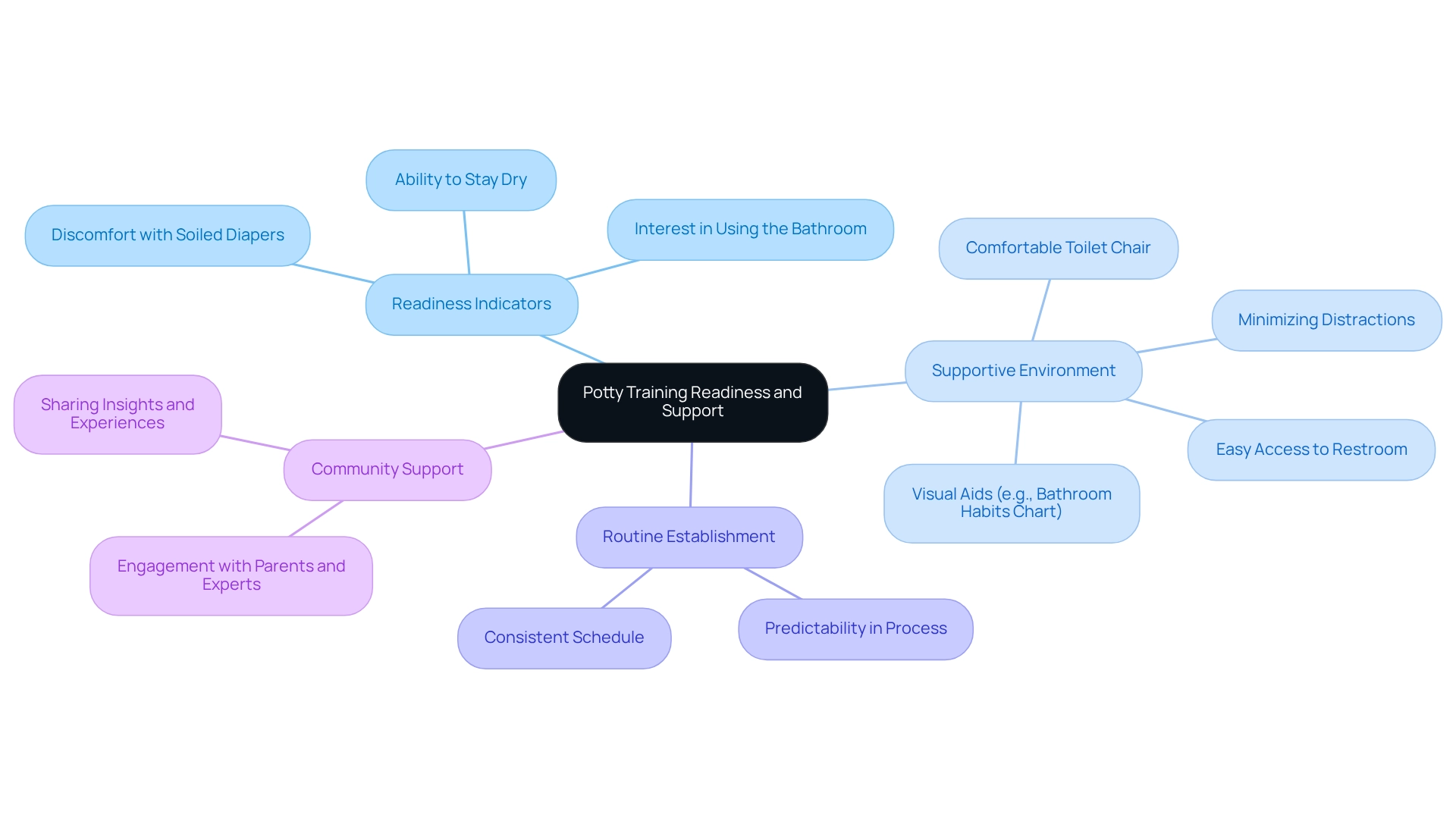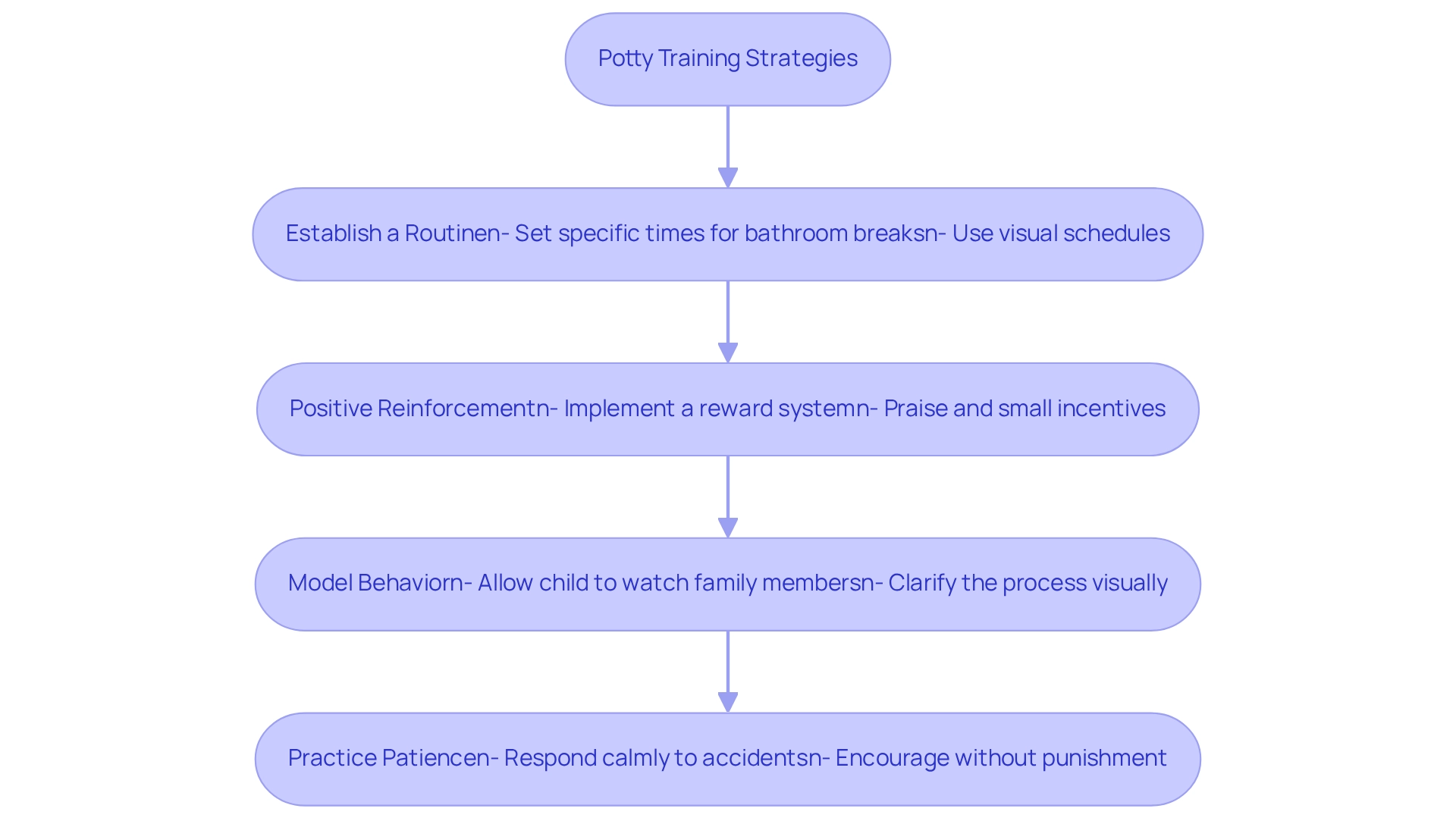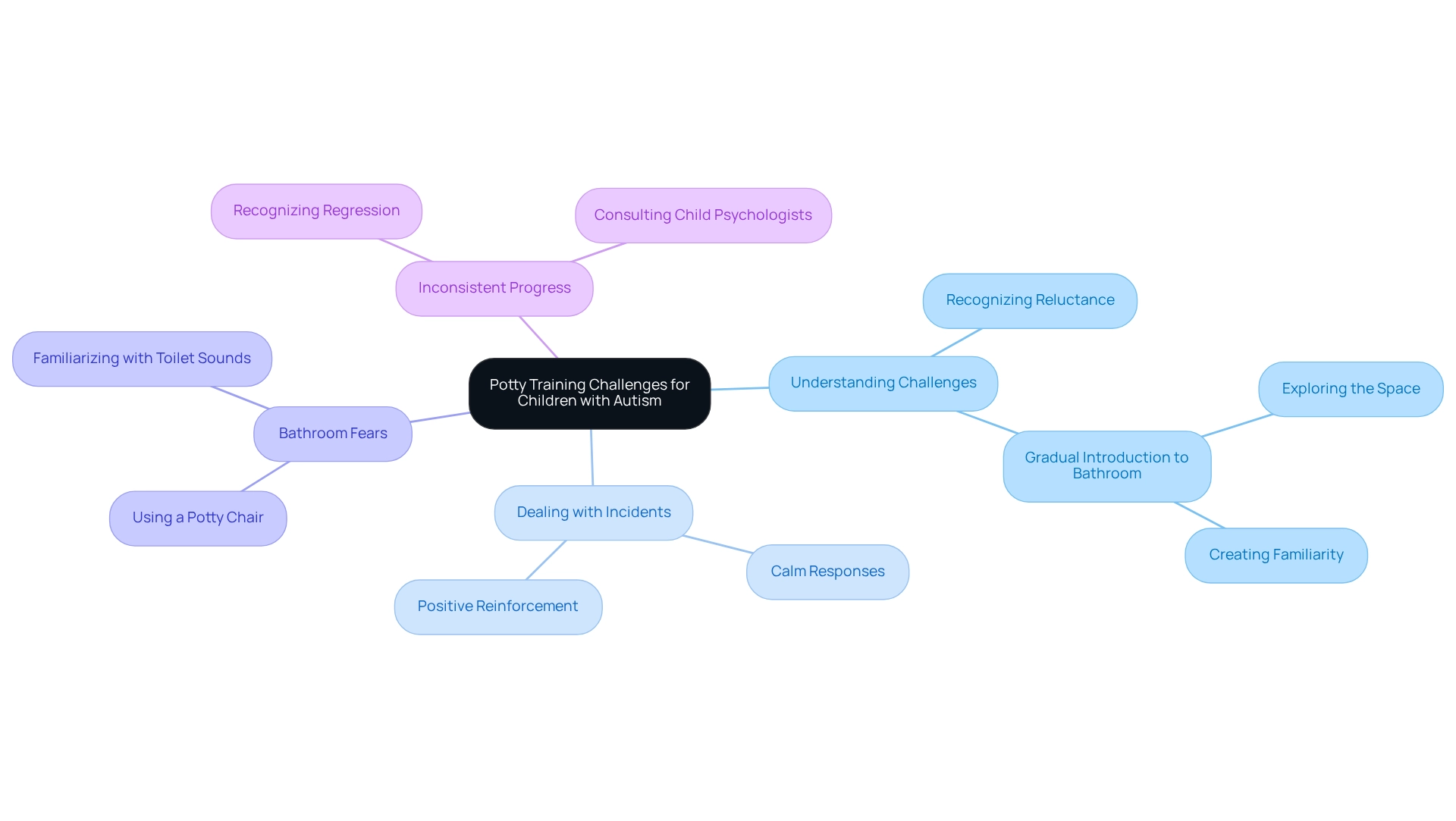Overview
This article shines a light on effective strategies for potty training a child with autism, recognizing the unique challenges that arise from sensory sensitivities and communication difficulties. Many parents may feel overwhelmed, but understanding these challenges is the first step toward finding solutions. By outlining step-by-step techniques, such as:
- Establishing consistent routines
- Utilizing positive reinforcement
- Creating a supportive environment tailored to your child's specific needs
we aim to enhance the potty training experience significantly.
Imagine the comfort that comes with knowing you have a plan in place. Establishing routines can provide structure, while positive reinforcement encourages your child and builds their confidence. Creating a nurturing environment that respects their unique sensory needs is crucial. Each of these strategies can make a world of difference, transforming a daunting task into a more manageable and even rewarding experience.
We invite you to share your experiences and insights in the comments below. Your journey can inspire others facing similar challenges. Remember, you are not alone in this process. Together, we can navigate the path to successful potty training with compassion and understanding.
Introduction
Navigating the journey of potty training can feel overwhelming for caregivers of children with autism, as it presents a unique set of challenges. Sensory sensitivities, communication difficulties, and behavioral issues can complicate this process, making it crucial to adopt tailored strategies that meet each child's specific needs.
In this article, we explore the intricacies of potty training for autistic children, offering insights into:
- Understanding these challenges
- Assessing readiness
- Creating a supportive environment
We provide effective, step-by-step techniques to implement during the training process, while also addressing common obstacles that may arise along the way.
With the right approach and understanding, caregivers can foster a more successful and positive potty training experience for their children. Together, let's embark on this journey with compassion and support.
Understand the Unique Challenges of Potty Training for Children with Autism
Understanding how to potty train a child with autism can be particularly challenging, largely due to sensory sensitivities and communication difficulties. Many autistic individuals experience heightened sensitivity to sensory stimuli, making the bathroom environment feel overwhelming. For instance, the sound of a flushing toilet or the chill of a cold toilet seat can trigger anxiety, hindering their ability to engage in this important learning process. Additionally, communication barriers may prevent a young person from expressing their needs, leading to frustration for both the child and their caregivers.
Behavioral issues, such as resistance to change and difficulties with transitions, can further complicate the toilet learning journey. A study involving 37 individuals diagnosed with autism, along with 41 diagnosed with ADHD and 43 typically developing individuals, highlights the importance of understanding these unique challenges, as they significantly affect the effectiveness of toilet training strategies. By recognizing and addressing these factors, caregivers can develop tailored approaches that cater to their child's specific needs, ultimately fostering a more effective experience when learning how to potty train a child with autism. Moreover, utilizing data from sensory assessments can help inform customized intervention programs, ensuring that strategies are personalized based on individual sensory sensitivities. As Alaa Salah noted, the authors declare no competing interests related to the study, reinforcing the credibility of these findings. Looking ahead, future studies should involve larger sample sizes and consider factors such as age to enhance our understanding of how to potty train a child with autism and the distinct challenges faced during toilet training. Together, we can create a supportive environment that empowers both children and their families through this essential milestone.
Prepare for Potty Training: Assess Readiness and Set Up a Supportive Environment
Evaluating your little one's readiness for how to potty train a child with autism is a crucial first step. Look for key indicators such as the ability to stay dry for extended periods, showing interest in using the bathroom, and expressing discomfort with soiled diapers. Recognizing these signs can empower parents in understanding how to potty train a child with autism by determining the right time to begin this important process.
Once readiness is established, it’s vital to create a supportive environment. This involves selecting a comfortable toilet chair that suits your child's needs, ensuring easy access to the restroom, and minimizing distractions during practice sessions. Visual aids, like a bathroom habits chart, can be particularly beneficial, helping children understand the steps involved in this journey.
Establishing a consistent routine is another essential aspect. Routines provide structure and predictability, which can ease the transition for children with autism, particularly when considering how to potty train a child with autism. By combining these strategies, parents can foster a positive toilet learning experience, which is crucial for understanding how to potty train a child with autism, ultimately leading to greater success and confidence for their little ones.
As the primary aim of ABA therapy is to enhance preferred behaviors, such as effective bathroom use, it’s important to understand how to potty train a child with autism, recognizing that each child progresses at their own pace. Case studies highlight the need for managing parental expectations regarding toileting timelines and success rates. For instance, the case study titled "Parental Expectations in Potty Training" illustrates how variability in children's readiness can significantly reduce frustration and create a more supportive atmosphere. Moreover, engaging with a community of parents and experts, as discussed in the case study on 'The Role of Community in Autism Awareness,' can enhance support and facilitate the sharing of valuable insights. This cooperative approach is essential for successful toilet training. As Stuart Duncan wisely states, "Autism is my superpower," reminding us to celebrate the unique strengths of our children as they reach this significant developmental milestone.

Implement Effective Potty Training Strategies: Step-by-Step Techniques
To effectively teach your little one to use the toilet, consider these nurturing, step-by-step techniques that can make a significant difference in their learning journey.
Establish a Routine: Setting specific times for bathroom breaks, like after meals or every couple of hours, can be incredibly helpful. Consistency is key, as it helps your child anticipate when to expect bathroom time, enhancing their toileting skills. Research indicates that establishing routines can lead to higher success rates in how to potty train a child with autism, and using visual supports by developing a visual schedule that outlines the steps involved in using the toilet can significantly help. Including images of the potty, washing hands, and putting on underwear makes the process more approachable. Research shows that visual schedules can improve comprehension and involvement, especially for individuals with autism.
Positive Reinforcement: Implementing a reward system can motivate your child. Praise them for sitting on the potty, regardless of whether they go. Small incentives, like stickers or treats, can effectively encourage participation and reinforce positive behavior.
Model Behavior: If appropriate, allow your child to watch family members using the toilet. This modeling can clarify the process and provide a clear illustration of what to expect, which is particularly beneficial for young learners who thrive on visual education.
Practice Patience: Remember, accidents are part of the learning process. Respond calmly and encourage your child to try again without punishment. This approach fosters self-assurance and reduces anxiety, enhancing the toilet learning experience, which is essential when considering how to potty train a child with autism and can lead to greater toileting autonomy among youngsters. Recent research emphasizes the success of organized interventions that focus on routine creation and positive reinforcement. Parents can significantly improve their child’s potty learning experience by concentrating on how to potty train a child with autism using these strategies. Furthermore, organizations like Hopebridge offer customized ABA therapy programs that provide families with personalized assistance on how to potty train a child with autism, tailored to the unique needs of each individual. As highlighted by Lauren M. Little, while most autism interventions have not yet established the ideal intensity and duration, it is crucial to consider the specific requirements of families and children when applying these strategies. Your journey in toilet training may have its challenges, but remember, you are not alone. Share your experiences and seek support, as every step forward is a step toward success.

Troubleshoot Common Potty Training Challenges: Solutions and Tips
Understanding how to potty train a child with autism can be a journey filled with unique challenges. Understanding these challenges is the first step toward fostering a positive experience for both you and your child, especially when it comes to how to potty train a child with autism; it's essential to recognize the reasons behind your child's reluctance. They might feel anxious or uncomfortable about the toilet. To help ease these feelings, consider gradually introducing them to the bathroom environment. Allow your child to explore this space without any pressure, creating a sense of familiarity and comfort. In fact, surveys indicate that 36.5% of autism caregivers utilize ABA therapy, and many report positive outcomes, illustrating the effectiveness of tailored approaches.
Incidents: Remember, incidents are a normal part of the potty training process. When they happen, respond calmly and reassure your child that it's okay. Encourage them to try again without any form of punishment, reinforcing a positive learning experience. This philosophy aligns with O. Ivar Lovaas's words: 'If they can't learn the way we teach, we teach the way they learn,' which is essential to understand how to potty train a child with autism. This adaptability is key to supporting your child's learning journey.
Fear of the Bathroom: If your child expresses fear of the bathroom, starting with a potty chair may provide a sense of security. Once they feel comfortable, you can gradually transition them to the regular restroom. Additionally, letting them flush the toilet without using it can help them get accustomed to the sound and process. Insights from the case study 'Embracing Neurodiversity' highlight the importance of recognizing and valuing the unique abilities of individuals on the autism spectrum, which can promote a more inclusive approach to how to potty train a child with autism.
Inconsistent Progress: It's natural for regression to occur, often triggered by changes in routine or stress. If you notice obstacles, take a moment to reassess your child's readiness for this developmental milestone. Sometimes, a break can be beneficial, allowing you to resume when they seem more prepared. Consistency and patience are vital in navigating these challenges. Consulting with child psychologists can offer expert solutions tailored to overcoming resistance to toilet use, including how to potty train a child with autism, ensuring that you have the support you need. By implementing these strategies, you can effectively support your child through the potty training journey, creating a nurturing and encouraging environment.

Conclusion
Potty training children with autism is a journey that calls for a thoughtful and compassionate approach. Recognizing the unique challenges these children face is essential. By understanding sensory sensitivities, communication barriers, and behavioral tendencies, caregivers can craft effective training strategies. Assessing a child's readiness and creating a supportive environment lays the groundwork for a more successful potty training experience.
Implementing structured, step-by-step techniques—like establishing routines, using visual supports, and providing positive reinforcement—can significantly enhance the learning process. Patience and adaptability are key, especially when facing common challenges such as resistance or fear of the toilet. Each child's journey is unique, and acknowledging this variability can help reduce frustration while fostering a more encouraging atmosphere.
Ultimately, the goal is to empower children with autism as they navigate this important developmental milestone. By embracing tailored strategies and maintaining open communication, caregivers can support their children in achieving greater independence and confidence during potty training. With compassion and understanding, this journey can transform into a positive experience for both children and their caregivers.
Frequently Asked Questions
Why can potty training a child with autism be particularly challenging?
Potty training a child with autism can be challenging due to sensory sensitivities and communication difficulties. Many autistic individuals may find the bathroom environment overwhelming because of heightened sensitivity to sensory stimuli, such as the sound of a flushing toilet or the chill of a cold toilet seat, which can trigger anxiety.
What role do communication barriers play in potty training for children with autism?
Communication barriers can prevent a child from expressing their needs during potty training, leading to frustration for both the child and their caregivers. This difficulty in communication can hinder the learning process.
How do behavioral issues affect toilet training in children with autism?
Behavioral issues such as resistance to change and difficulties with transitions can complicate the toilet learning journey for children with autism. These challenges can make it harder for caregivers to implement effective toilet training strategies.
What does research indicate about the challenges of potty training children with autism?
A study involving individuals diagnosed with autism, ADHD, and typically developing individuals highlights the importance of understanding the unique challenges faced by autistic children during potty training. Recognizing these factors is crucial for developing effective training strategies.
How can caregivers create a more effective potty training experience for children with autism?
Caregivers can develop tailored approaches that cater to the specific needs of their child by recognizing and addressing sensory sensitivities and communication barriers. Utilizing data from sensory assessments can help inform customized intervention programs.
What future research is suggested to improve our understanding of potty training for children with autism?
Future studies should involve larger sample sizes and consider factors such as age to enhance our understanding of potty training challenges faced by children with autism. This could lead to better strategies and support for families during this essential milestone.




